While the men had a Code of Points in place for the 1950 World Championships, the women did not. But they did have a book of General Instructions. What follows are the highlights.
The Program | Routine Composition Guidelines | On Judging | On Scoring | Additional Rules | Apparatus Norms | Compulsory Routines | Documents | Appendix A: Men’s Rythmic | Appendix B: The End of Ensemble Exercises in WAG
The Program
Compulsory and optional exercises on the following events:
- Floor exercise (without music)
- Balance beam
- Flying rings OR uneven bars
- Vault without handles and with a “tremplin dur”
In addition: Ensemble floor exercise with hand apparatus and music
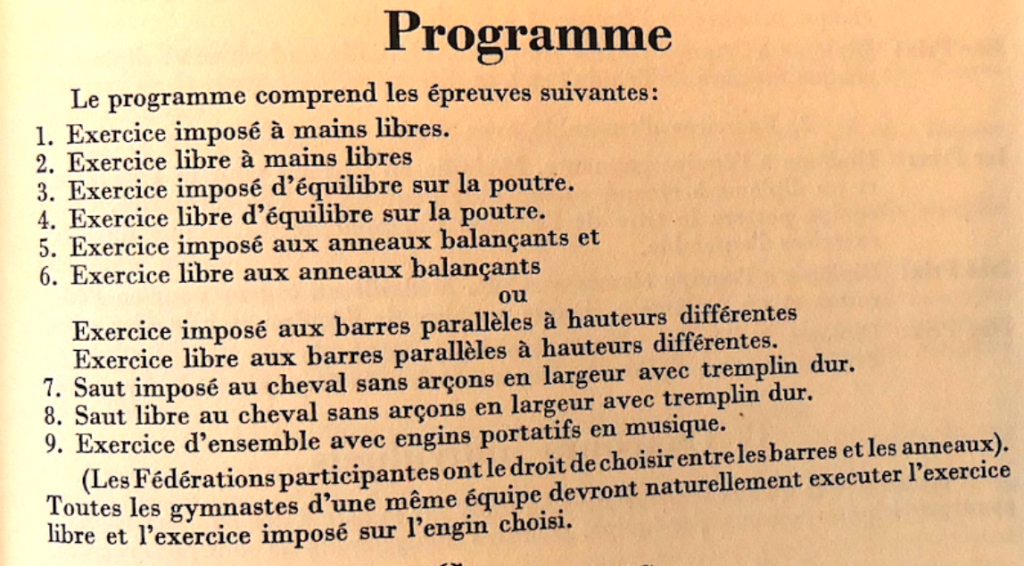
Note #1: The gymnasts could not mix and match flying rings and uneven bars. They had to perform compulsory and optional routineson one or the other.
Note #2: At the 1948 Olympics, the women’s teams had two ensemble exercises: one with hand apparatuses and one without. The latter was replaced by individual floor exercise routines.
The 1950 World Championships were the first time the women’s artistic gymnasts competed individually on floor at an FIG-sanctioned event.
Note #3: Speaking of firsts, the 1950 World Championships were the first time that there were individual apparatus awards in women’s artistic gymnastics.
The Team Competition
- The team competition included the 9 events listed above.
- Each team consisted of 10 members with 8 members participating on each event.
- Before 6 o’clock, the evening before the competition starts, each team had to submit its list of 8 gymnasts who would take part in the competition and the order in which they would compete.
- The team total was made up of the top 6 all-around scores on each team.
- The competitors and their coach (directrice) received medals.
- There was a team all-around medal, as well as team medals for the ensemble exercise.
Routine Guidelines
On compulsory exercises
The compulsory exercises can be executed exactly as described or they can be reversed but only in their totality.
In other words, if the compulsory description indicated a left-handed cartwheel, a gymnast could do a right-handed cartwheel.
General Guidelines
The individual optional exercises should contain four to five elements of the highest difficulty level. All strength and power exercises are considered undesirable; preference is given to the exercises with finesse. The optional exercises should differ from the compulsory exercises and from one gymnast to another. The elements in the compulsory exercises, even reserved, are considered similar and consequently are not judged.
Floor Exercise
The floor exercise should include artistic movements and somersaults, with life, of positions, of balances, of traveling movements, of expression, of sentiment, of elegance, of individuality, and of originality.
Note #1: This is taken directly from the 1948 men’s guidelines for floor exercise.
Note #2: The women’s artistic gymnasts didn’t have floor music for their individual exercises. They had music for their ensemble exercises.
Vault
Many gymnasts from the same team can perform the same vaults. Vaults without touching the horse are not permitted.
Ensemble Exercises
Exercises with portable apparatuses should work the entire body. The beauty of the formations must also be considered, which obviously must not be detrimental to the physiological value of the composition. Each gymnast will have their own personal apparatus which will not necessarily be the same for all. The devices chosen will have to increase the difficulty of the movements and should be corrective in nature. The whole exercise should work all gymnasts throughout the exercise. The ensemble routine will be required. The exercise will be accompanied by music. The rhythm, the character of the music must correspond to the movements.
On Judging
3 to 5 Judges per Country
Each federation will nominate under its responsibility as members of the Jury 3-5 women whose competence and fairness are above all suspicion and who in the competitions of their Federations have perfected judging. The names and qualities of the judges, as well as their addresses, must reach the President of the Women’s Technical Commission, Mrs. Buddeusová, at the latest one month before the competition. The duplicate will be sent by the same mail to the secretary general, Mr. Thoeni.
Note: In case you were wondering who took over the Women’s Technical Committee after Marie Provazníková defected during the 1948 Olympics, it was a fellow Czechoslovak Nora Buddeusová, who stepped down from her position shortly after the World Championships.
All judges were women.
Only women can be members of the women’s jury.
A solemn agreement to avoid bias.
When accepting their office, the members of the Jury solemnly agree to work conscientiously, without regard to either the person or the nation.
The members of the Jury dedicate themselves entirely and exclusively to the events of the competition, they cannot lead a team, take part in the exercises, or accept other responsibilities.
A Judging Course
In order to arrive as much as possible at a uniform assessment scale, a penalty scale will be established and a 2-day compulsory judging course will be organized before each competition for all juries entered. Juries who could not participate in this course will not be admitted.
Note: In 1948, there was also an obligatory judging course for the women’s artistic gymnastics judges.
The FIG didn’t pay the judges.
The members of the Jury will not be entitled to any compensation for travel and subsistence expenses. The organizing federation will however examine the possibility of covering part of these costs.
Note: In 1950, the FIG had a total of 3,605 Swiss Francs in the bank (100 Years of the FIG).
The Role of the Women’s Technical Committee
The president or vice-presidents of the Technical Committee function as president and vice-presidents of the Jury. They will convene and install the Jury for the day, at the time and at the determined room.
The President, the Vice-Presidents of the Jury and the Technical Director will form the Jury of Appeal in the event of a protest.
The score sheets will be provided to the Jury in accordance with the model adopted by the Executive Technical Commitee.
On Scoring
Five Judges
On the individual events, the Jury will be made up of 5 judges.
Note: The 1958 Women’s Code of Points would continue the tradition of using 5 judges. In 1968, the Women’s Technical Committee adopted the men’s structure of four judges and a superior judge.
Judging is not a group project
The 5 judges can consult each other for the first exercise in order to find a common starting point.
Thereafter, they will work independently of each other and will no longer consult each other except in exceptional cases (accident, etc.).
All scores shown; average of the three middle numbers.
The Organizing Committee will install a device allowing the 5 judges to show simultaneously to the public and to the competitors the points that each of them has given. Only the 3 middle notes will be taken into consideration for the result. The score will be established by dividing the total of the three average scores by three.
Note: In 1948, the women’s artistic gymnasts had four judges per event.
Judges can be replaced
The president of the Jury can exclude and have replaced a Jury who does not proceed in a sufficiently correct way.
Note: Remember this rule because things got wild on vault at the 1950 World Championships.
Compulsory exercises (out of a 10 — 7 points for execution and 3 points for general impression):
The compulsory exercises are scored from 0 to 10 points, by tenths of points. Being the same for all the competitors, execution alone is subject to assessment. They are judged for exactness, elegance and assurance of execution.
An exercise performed perfectly and in full is scored for a maximum of 10 points:
7 points for the execution of all parts and combinations of the exercise,
3 points for the general impression.
To facilitate and to bring together the points of view on the score, the compulsory exercise will be broken down into parts and each part will be scored at a proportional value, a maximum of 7 points. Then a list of faults with their relative importance will be established.
Optional exercises (out of a 15):
They will be scored from 0 to 15 points, in tenths of points. […]
The optional exercises should contain 4 to 5 elements of the highest difficulty. Their technique will be exclusively feminine adapted to the morphology of young girls.
Duration of optional exercise on the beam: 1 minute 30 to 2 minutes.
Duration of the floor exercise: 1 minute to 1 minute 30.
Vault
Perfect execution is scored 10 points plus a maximum of 5 points for difficulty and combination detailed as follows:
3 points for difficulty
2 points for the combination
Compulsory vaults: Are scored from 0 to 10 points by tenths of points. Perfect execution is rated:
1 point for the approach
7 points for the jump itself
2 points for landing.
Optional vaults: Are scored from 0 to 15 points by tenth of points. To the execution, add a maximum difficulty rating of 5 points. The vault difficulty will be fixed according to the scale of vaults established by the Executive Committee.
Ensemble Exercises
- Out of 80 points
- 8 judges of different nationalities
- 2 high scores and 2 low scores are dropped
- Remaining 4 scores are multiplied by two
They will last for a minimum of 4 minutes and a maximum of 5 minutes.
They will be judged by a group of 8 ladies of different nationalities who will each give a maximum score of 10 points. The final mark for an overall exercise will therefore be a maximum of 80 points.
Of the 10 points that will be available to each juror, the following will be awarded:
2.5 points for the difficulty of the exercise and its physiological value
2.5 points for the beauty and the combination of the exercise
5 points for correct execution and overall interplay.
The final score will be established as follows: the 2 highest and the 2 lowest scores will be eliminated and the total of the remaining scores will be multiplied by two.
Maximum Scores
The number of points that a team can obtain:
4 compulsory routines: 40 points x 6 gymnasts = 240 points
4 optional routines: 60 points x 6 gymnasts = 360 points
1 ensemble routine = 80 points
Total: 680 points
The number of points that an individual can obtain:
The maximum score per apparatus: 25 points [10 for compulsory + 15 for optionals]
The competition total: 100 points
Additional Rules
No repetitions
No routine can be repeated except for vault
On Beam Falls
It was brutal.
Beam: Both for the compulsory and optional exercises, if the gymnast falls from the beam, she can resume the exercise from the moment of the fall and continue until the end. She will receive the score for the whole exercise minus 2 points for the fall. On the second fall, she can no longer repeat the exercise and will obtain the score corresponding to the part of the exercise performed, reduced by 2 points for the first fall.
Best of Two Vaults
Vaulting apparatus: Both compulsory and optionals, each gymnast is entitled to 2 attempts. Best attempt is counted.
On Attire
Competition attire must be uniform for all gymnasts on the same team. They must wear a common badge. The outfit cannot be changed or modified during the competition except for the ensemble exercise.
Provisional Schedule
July 14, 1950: Compulsory and optional exercises on floor and beam
July 15, 1950: Compulsory and optional exercises on rings/uneven bars and vault
July 16, 1950: Ensemble exercises
Apparatus Norms
Balance Beam
| Dimension | 1936 | 1950 | 2022 |
| Length | Approx. 5 m | 5 m | 5 m |
| Width | 8 cm | 10 cm | 10 cm |
| Height | 120 cm | 120 cm | 125 cm |
| Thickness | NS | 16 cm | 16 cm |
Would you compete on an 8 cm balance beam?
Flying Rings
| Dimension | 1950 |
| Height of Portico | 5.50 m |
| Interior Diameter of Rings | 18 cm |
| Diameter of Rings | 28 mm |
Note: These dimensions hadn’t changed from 1948.
Additional specifications in 1950: The ropes can end with straps or movable straps to which the rings are attached. The rings at the height of the raised hands must be easily adjustable using a latch allowing easy lengthening or shortening of the ropes as required. Polished wood rings.
Uneven Bars
| Dimension | 1950 | 1965 | 1967 | 2022 |
| Height of High Bar | 2.30 m | 2.30 m | 2.30 m | 2.50 m |
| Height of Low Bar | 1.50 m | 1.50 m | 1.50 m | 1.70 m |
| Spread of the Bar | 42 to 46 cm | 43 to 52 cm | 50 to 58 cm | See Below |
Additional Notes in 1950: Oval-shaped bars (Barres de forme ovale)
Note #1: The 1950 dimensions listed above were also the dimensions used at the 1936 Olympics.
Note #2: Nowadays, the spread of the bars is measured as the distance from high to low bar. In 1950, the distance from high to low bar would have been about 90.35 to 92.28 cm. In 2022, that distance is 130 cm to 180 cm.
Note #3: At the 1967 European Championships, the FIG started using tension bars with cables. You can read about the change here.
Vault
| Dimension | 1950 |
| Length | 1.80 m |
| Width | 35-37 cm |
| Height from Floor | 1.10 m |
Note #1: In 1948, the women’s artistic gymnasts could use the pommels if they wanted. In 1950, there were no pommels.
Note #2: Twenty years later, in 1968, the women’s vault was still 1.10 meters high. Today, the highest part of the vault table is 1.25 cm. (So, about 5.91 inches higher)
Beat Board (Tremplin Dur)
Beat Board
Height of the board: 10 cm
The distance of the board is open in all cases.
For the optional exercises on uneven bars and on beam, the use of the beat board on the mat will be allowed.
Note: This is different from the 1948 Olympics, where the female gymnasts used a springboard (tremplin élastique).
More info: Curious about the evolution of boards? Here’s some more information.
Floor
Here were the specifications:
It will have minimum dimensions of 10 x 10 m. clearly drawn on the ground by means of white lines. In the case of a raised floor, it must be at least 12 x 12 m, the space available to the gymnast always remaining 10 x 10 m.
Note: On the men’s side, the floor was 8 x 8 m at the 1936 Olympics.

Thanks to a request from the Hungarian delegation at the 1950 FIG Congress, the floor area would be increased to 12 x 12 m in 1952.

The Organizing Committee was in charge of the apparatus. Teams could no longer bring their own.
All apparatus must be made available by the Organizing Committee. The latter is required to comply with regulatory provisions as well as with the instructions given by the Executive Committee.
A double set of apparatus will be used for team training a few days before the competition. No nation will be allowed to use its own equipment in the competition.
The Executive Committee will delegate one or more persons who will check, in good time before the competition, the condition and dimensions of the apparatus.
Note: In 1948, the teams could bring their own apparatus. The British women’s team vault disappeared for a bit.
Compulsory Routines
Women’s gymnastics was still developing. In 1950, the compulsory beam routine included a backward shoulder roll, and the floor routine included a front handspring.
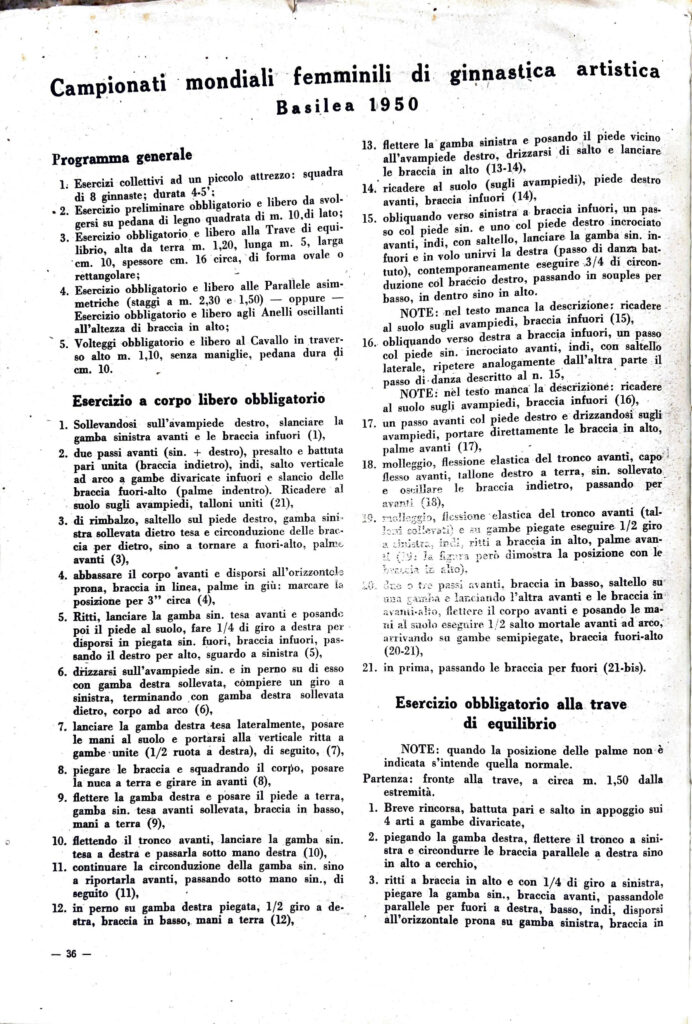
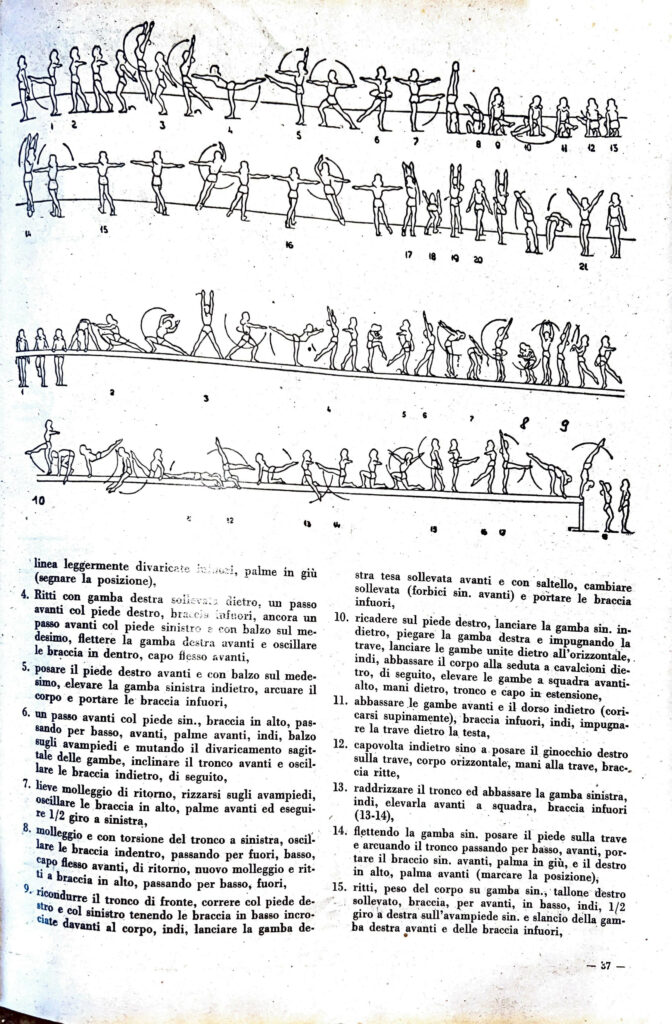
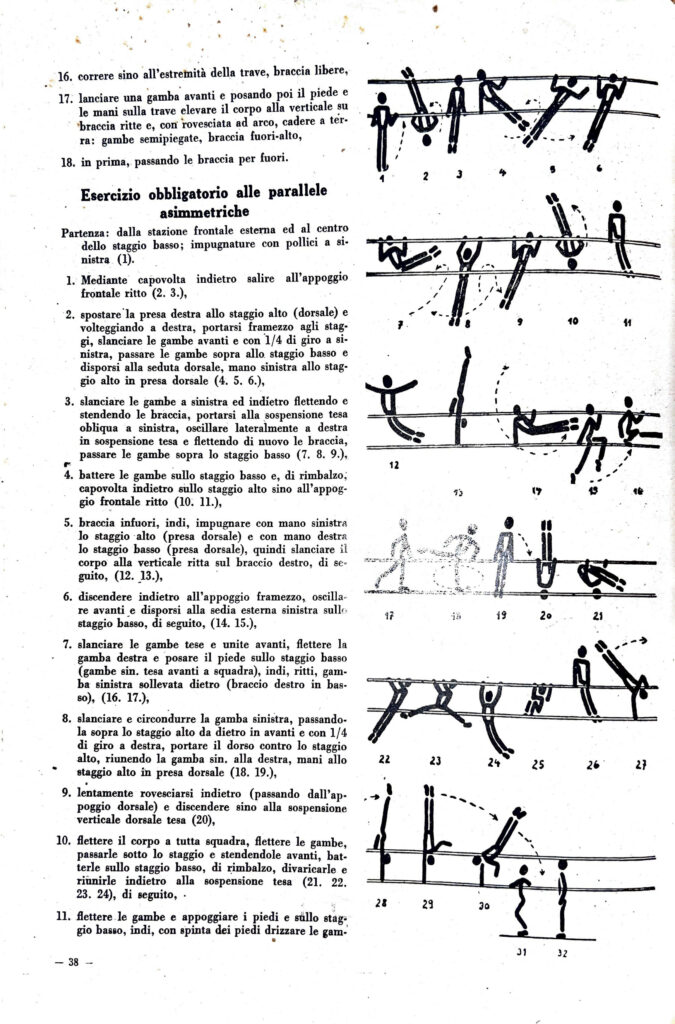
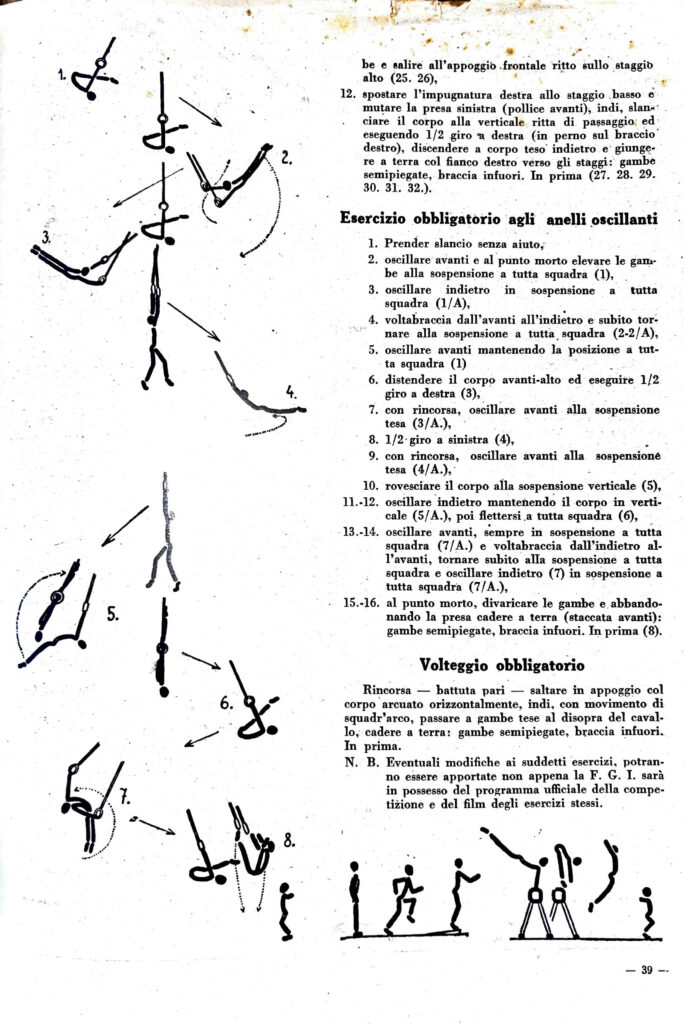
Documents
Thanks to Hardy Fink for supplying the General Instructions.
Appendix A: Men doing Rhythmic Gymnastics
After the 1950 World Championships, there was much debate about whether the ensemble exercises should be their own sport. We’ll discuss that debate in my next post on the women’s gymnastics competition at the 1950 Worlds.
For now, I want to note that many gymnastics traditions had men performing rhythmic gymnastics (i.e. performing with portable hand apparatus).
For example, in this book on British gymnastics from 1898, you can see men doing exercises with iron wands.
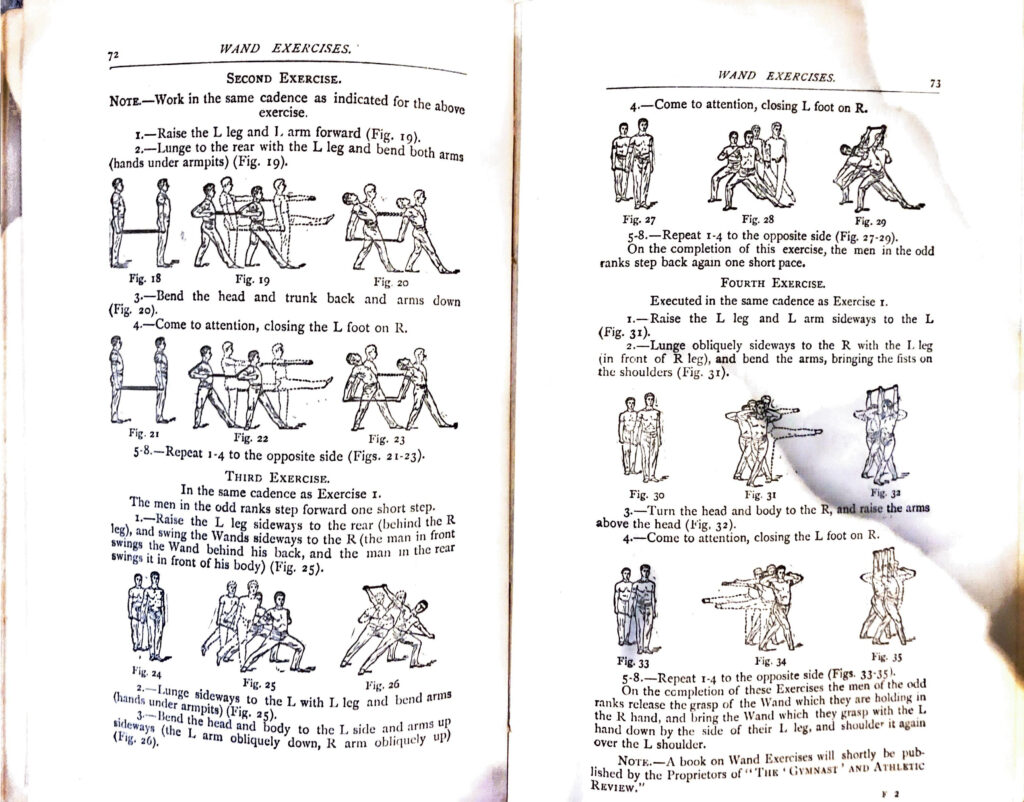
And in this German-American book from 1896, you can see exercises for men using clubs.
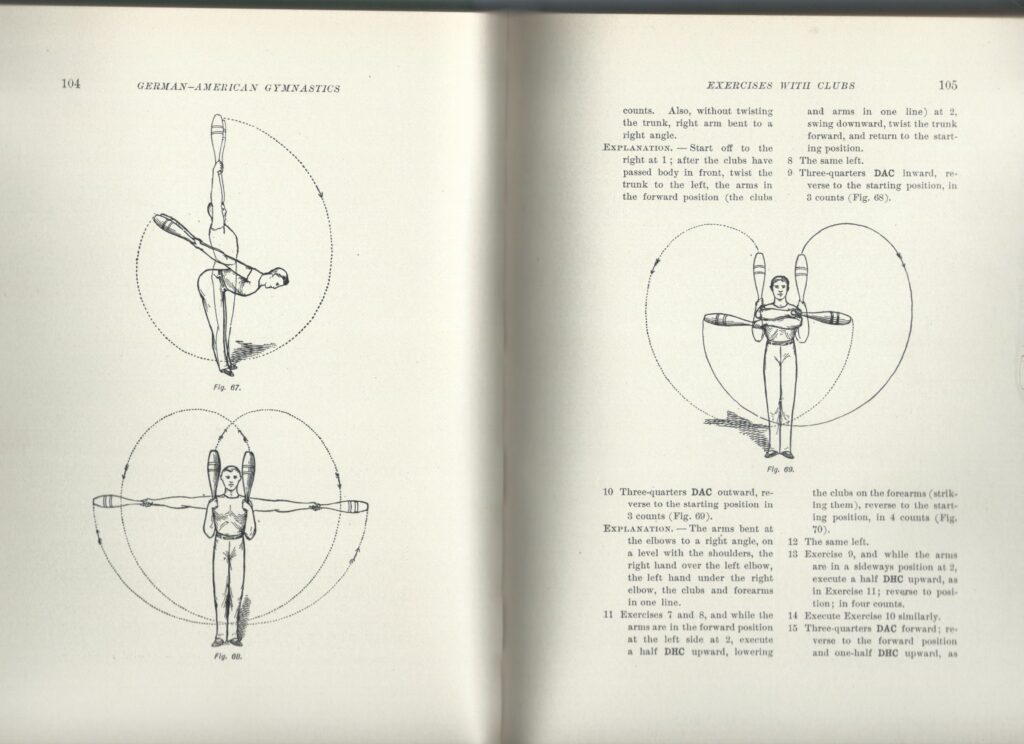
At the 1932 Olympics in Los Angeles, the clubs made an appearance as an individual event, which George Roth won.
But before that, there were ensemble exercises for men with the option of portable apparatus.
From the rulebook for the 1908 Olympics:
TEAM COMPETITIONS (1 team to represent each country).
Voluntary Mass Exercises. The exercises may be those known as free gymnastics or exercises with hand apparatus, or any combination of both or either.
Teams of not less than 16 nor more than 40.
Time limit, 30 minutes.
Official Report of the Fourth Olympiad, London, 1908
At the 1912 Olympics, during one of the team categories:
a series of free exercises in unison, with or without hand apparatus (such as wands, sticks, dumbbells, clubs, etc.)
Programme et règlement, Gymnastique, Ve Olympiade, Stockholm, 1912
And at the 1920 Olympics:
A series of free ensemble exercises or a series of ensemble exercises with instruments (such as wands, sticks, clubs, etc.). The composition of this series is left to the choice of each nation. However, fencing and military exercises are excluded. Teams performing exercises with instruments are requested to bring these items.
Time allowed: 10 to 15 minutes maximum, arrival, progress and departure included.
Une série d’exercices d’ensemble libres ou une série d’exercices d’ensemble avec instruments (tels que bâtons, cannes, massues, etc.). La composition de cette série est laissée au choix de chaque nation. Toutefois, les exercices d’escrime et militaires sont exclus. Les équipes qui produiront des exercices avec instruments sont priées d’apporter ces objets.
Temps accordé: de 10 à 15 minutes au maximum, arrivée, évolution et départ compris.
Programme et règlement, Gymnastique, VIIème Olympiade, Anvers, 1920
Separately, the rules noted:
The list of instruments and apparatus which the various teams will bring, or which they wish to use, must be sent to the Organizing Committee by May 1, 1920 at the latest.
La liste des instruments et engins qu’apporteront les différentes équipes, ou dont elles désirent se servir, devra être adressée au Comité d’organisation le 1 mai 1920 au plus tard.
Programme et règlement, Gymnastique, VIIème Olympiade, Anvers, 1920
The Soviet Union
Typically, when the history of rhythmic gymnastics is told, there is mention of the Soviet women’s program. In Modern Rhythmic Gymnastics (1976), Andrea Bodo Schmid writes:
Modern rhythmic gymnastics started as an independent competitive feminine sport in Russia in the early 1950s. This new sport, which developed grace, poise, and femininity in the performer, gained popularity in Eastern European countries where it was called “Artistic Gymnastics” because it was considered an art of self expression.
Note: The author was a member of the 1956 Hungarian team and defected to the United States.
Note #2: Rhythmic gymnastics started earlier than the 1950s in the Soviet Union. An article from Pravda Ukrainy on December 28, 1949 opens with this sentence:
All-Union competitions in artistic and rhythmic gymnastics and acrobatics ended in Kyiv.
В Киеве закончились всесоюзные соревнования по спортивной и художественной гимнастике и по акробатике.
Pravda Ukrainy on December 28, 1949.
What I find interesting is that this wasn’t just a women’s sport. Soviet men also participated in rhythmic gymnastics. In this Soviet book from 1953, you can see men using the ball…
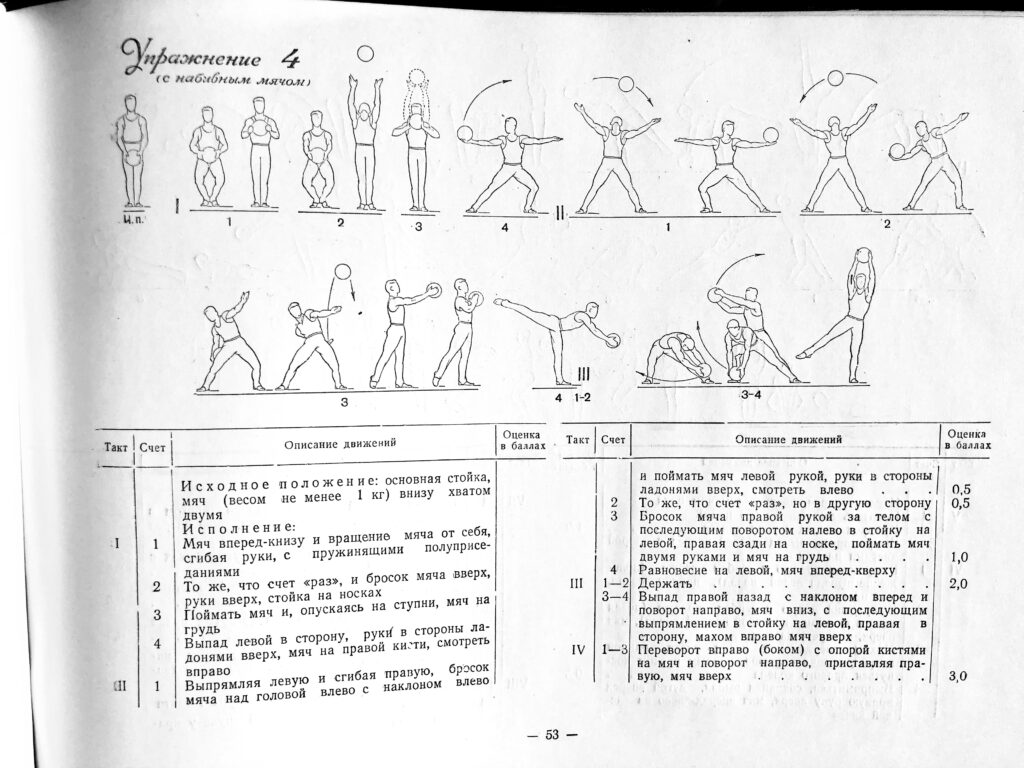
…the rope
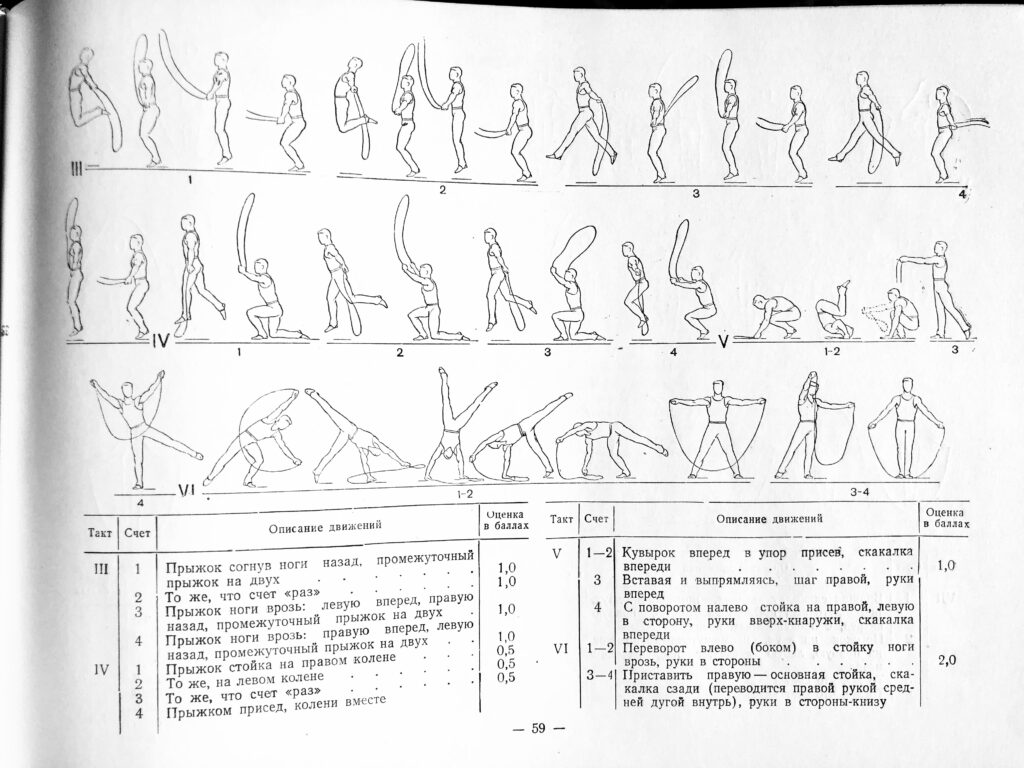
…the club.
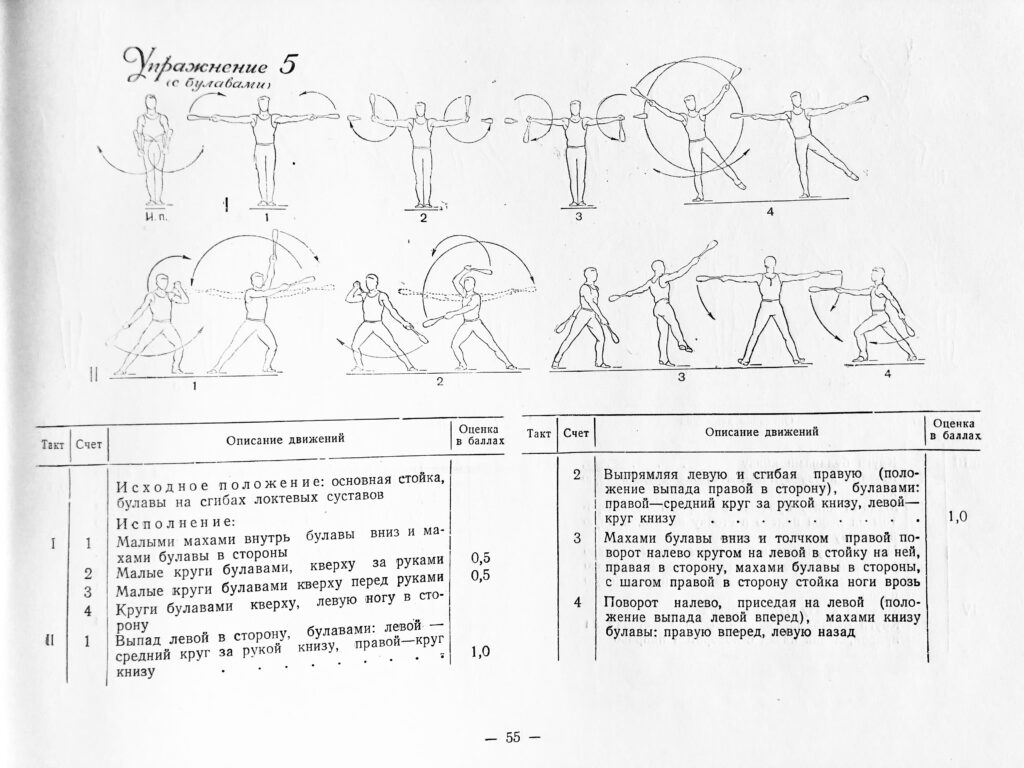
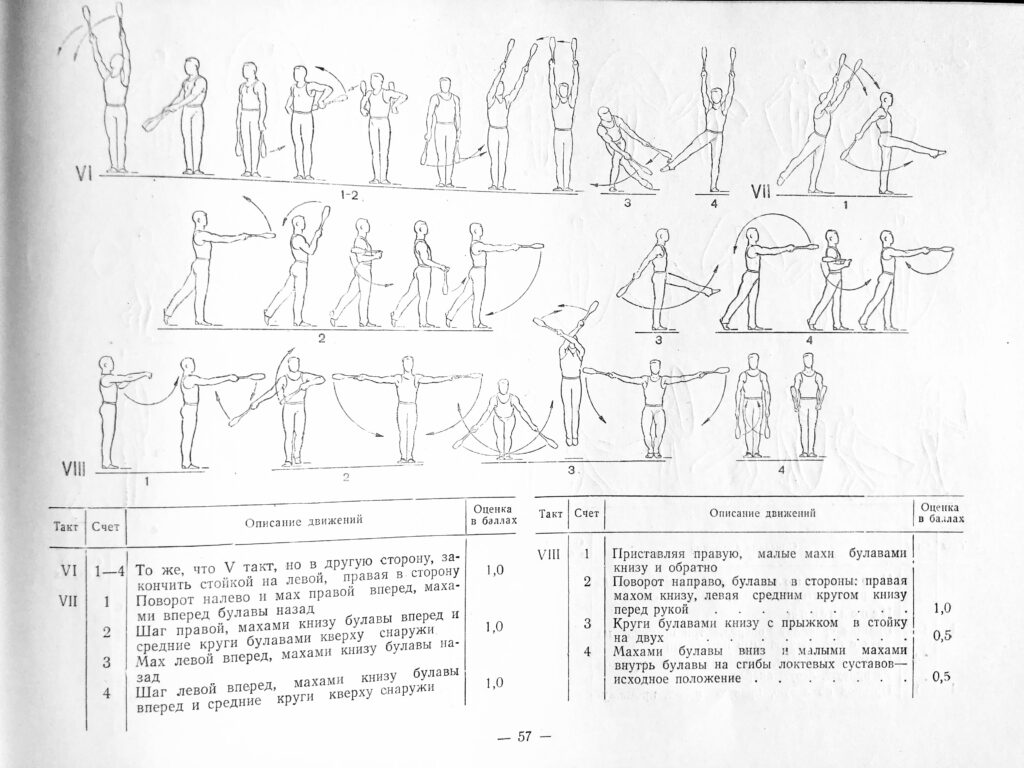
Japan
Today, the Japanese men are perhaps the most salient examples of men’s rhythmic gymnastics. Here’s a performance in Russia:
A Note on the Gendering of the Apparatus
Once upon a time, the apparatuses weren’t so rigidly divided between men and women. As we saw, the flying rings were an event for men and women in the German tradition.
Similarly, in the German tradition, men used to do uneven bars. You can see it in this 1921 book called 50 Turntafeln für das Geräteturnen der Männer (50 Exercises for Men’s Apparatus Gymnastics).
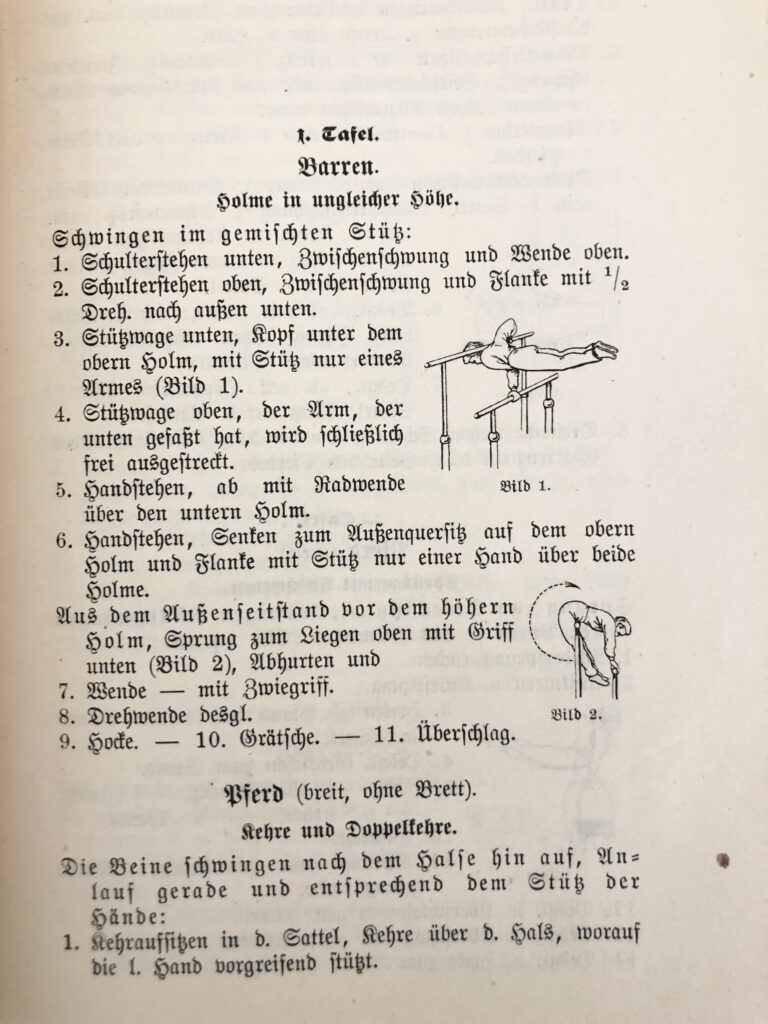
Men did balance beam too in the German-American tradition.
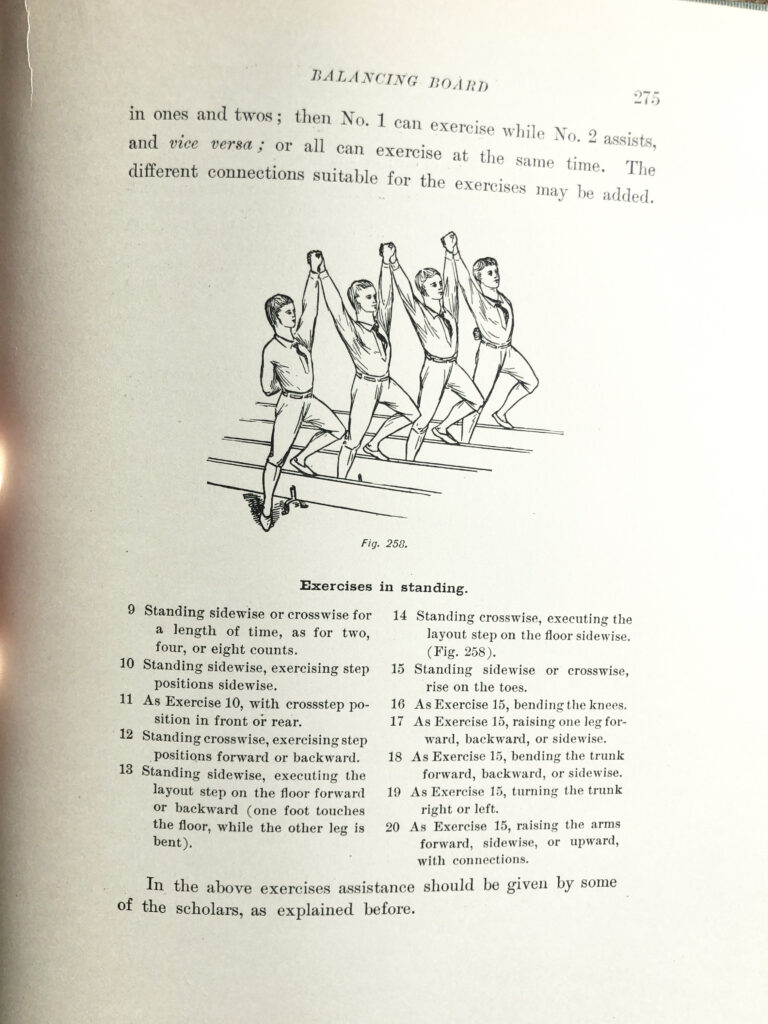
And in the Italian tradition.
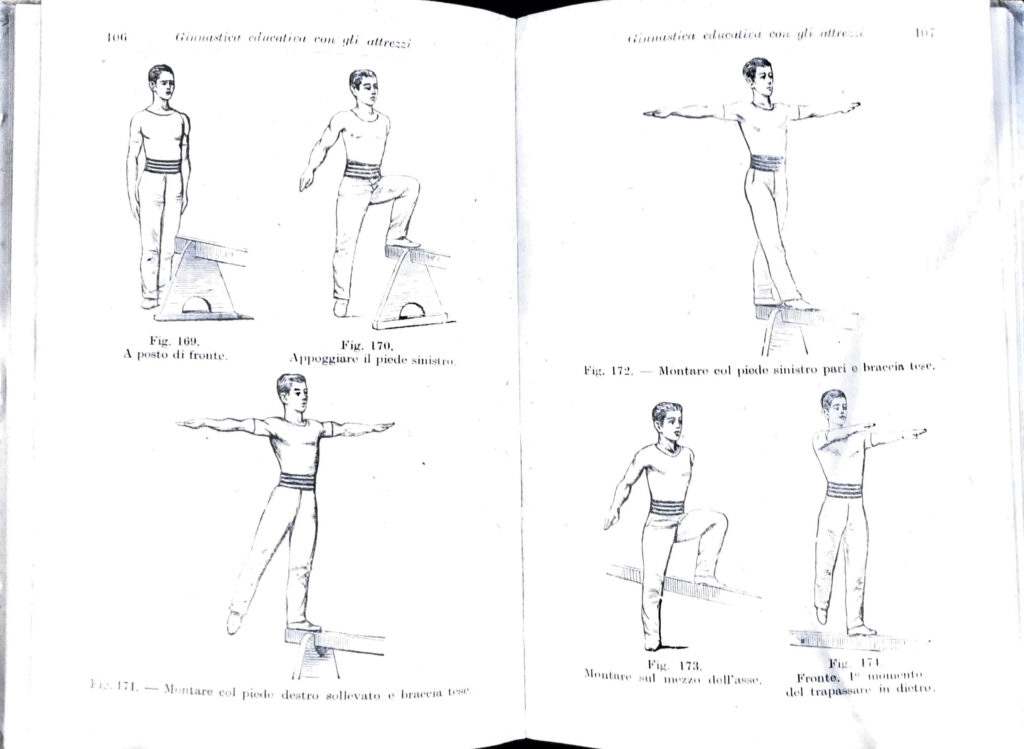
In fact, during the 1912 Olympics, during the Swedish ensemble exercises, men could compete on balance beam — as seen here in this photo from the Official Report on the Stockholm Olympics:
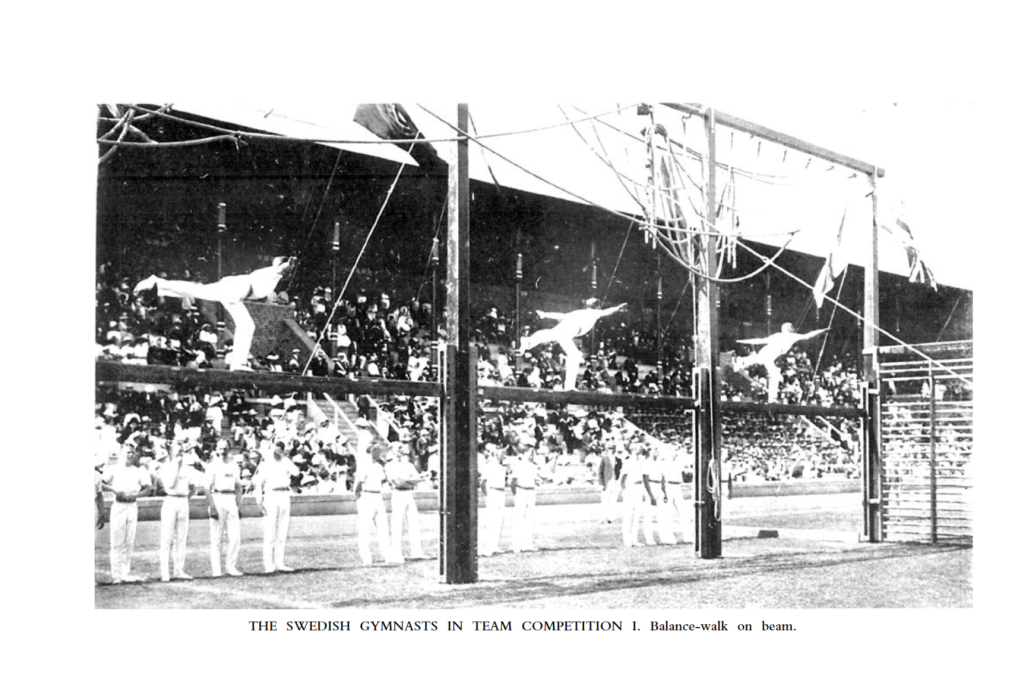
As part of the Swedish system, gymnasts had access to:
- 4 beams (double);
- 20 ribbstalls (stall-bars), available from both sides, thus enabling 40 competitors to perform simultaneously ;
- 2 inclined ropes;
- 24 vertical ropes;
- 2 horses with adjustable legs;
- 3 plinths (vaulting-boxes);
- 1 buck with adjustable legs;
- 6 benches with balance-bar and movable hooks;
- 8 beam-saddles
We’ll look a little more at the 1912 competition format in an upcoming post.
In women’s gymnastics, gymnasts opted to compete on parallel bars at the 1928 Olympics. At the 1934 World Championships and the 1936 Olympics, gymnasts had a choice of parallel bars or uneven bars for their optional routines.
In the German tradition, the women competed on high bar, for example.
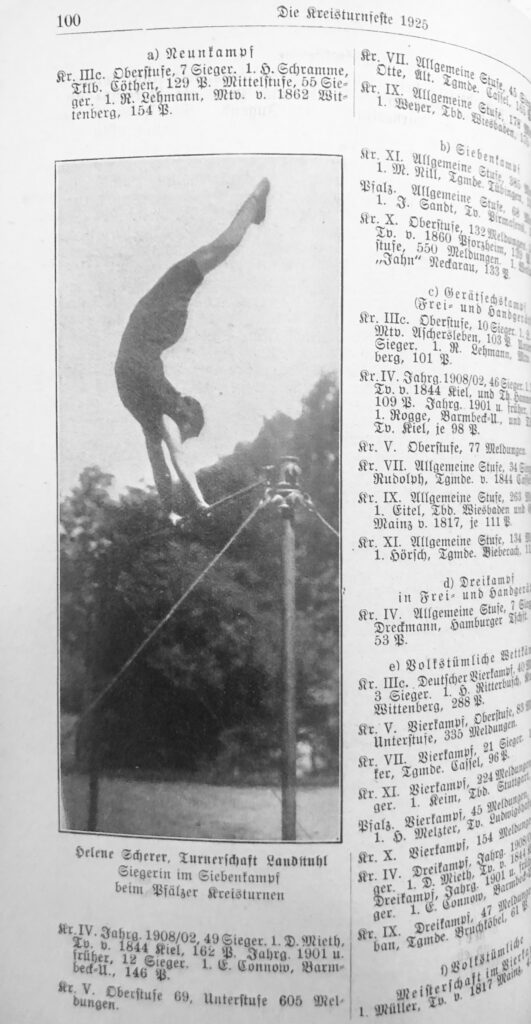
To cite another example, in the Soviet tradition, the women competed on six events just like the men. In 1943, in fact, the women competed on the same events as the men.
Moral of the Story: If you identify as a man who likes doing beam or as a woman who likes doing parallel bars, you simply like doing old-school gymnastics. 😀
Appendix B: The end of ensemble exercises
Ensemble exercises were struck from the women’s artistic gymnastics program after the 1956 Olympics, and in 1963, the first World Championships for gymnastique moderne (rhythmic gymnastics) were held.
Here’s what the FIG leadership wrote to the IOC in 1957:
VERY IMPORTANT
Mr. President
Gentlemen of the IOC,
In its XXXVI Congress, which took place in Zagreb from July 5 to 9, 1957, in order to comply with the provisions contained in Article 41, 3rd paragraph of the Olympic Rules, according to which,
“In team events where the ranking is based on the results obtained in the individual events, no competitor may receive more than one medal for the same performance.”
The International Gymnastics Federation has decided to make the following changes with regard to gymnastics competitions at the Olympic Games:
1. The team classification is maintained in its current form: also maintained the general individual classification, based on the results of the competition in 12 events for men, 8 for women, i.e. 1 optional exercise and 1 compulsory exercise on each apparatus, being understood that, if necessary, the gymnast would have the choice between the medal of the team or that of his individual general classification.
2. The ensemble exercise in women’s competitions is canceled. Demonstrations preceding the distribution of medals are also canceled. These demonstrations will be replaced by …
3. Special apparatus championships [event finals], in which the six best gymnasts in each apparatus may participate, in the events counting for the team classification. These championships will certainly be of much more interest than just demonstrations; experience on this subject has, moreover, amply proved it. The medals will be distributed at the end of each event.
This new formula for gymnastics competitions will not lead to any increase in time, but it will have the great advantage of being in absolute accordance with the provisions of the 3rd paragraph, the granting of more than one medal for the same performance.
We know that in some sports circles, even closely related to the IOC, it is sometimes felt that in the Olympic Games, gymnasts receive too many medals, which, in our opinion, does not stand up to an objective examination of the matter. In gymnastics, even the specialist in this or that apparatus, must present himself to all the events counting for the team classification or the individual general classification, which is peculiar to our sport. The prevailing idea and which has always prevailed in gymnastics is the training of the complete gymnast, which however does not exclude specialization in the different apparatus. An event on one or another of our apparatus requires as much training and effort as an event in any sport where medals are not contested. A gymnast does not reach his form which allows him to face with some chances of success the big international competitions only after long years of training and perseverance which certainly also deserve their reward.
In accordance with art. 30 of the Olympic Rules, we hasten to submit to you our proposals for gymnastics competitions at the Olympic Games, asking you to approve them.
Assuring you of our fidelity to the Olympic ideal, we ask you to accept, Mr. President and Members of the IOC, the assurance of our highest consideration.
On behalf of the FIG:
President: Charles Thoeni
President of the Men’s Technical Committee: Pierre Hentgès
President of the Women’s Technical Committee: Berthe Villancher
TRES IMPORTANT
Monsieur le Président,
Messieurs les Membres du C.I.O.
Dans son XXXVIe Congrès, qui a eu lieu à Zagreb au 5 au 9 juillet 1957, afin de se conformer aux dispositions contenues à l’article 41, 3e alinéa des Règles olympiques, selon lesquelles,
« dans les épreuves d’équipes où le classement est base sur les résultats obtenus dans les épreuves individuelles, aucun concurrent ne pourra recevoir plus d’une médaille pour la même performance ».
La Fédération Internationale de Gymnastique a décidé d’apporter les modifications suivantes en ce qui concerne les concours de gymnastique aux Jeux Olympiques:
1. Le classement par équipes est maintenu dans sa forme actuelle: maintenu aussi le classement général individuel, basé sur les résultats du concours en 12 épreuves pour les hommes, 8 pour les dames, soit 1 exercice à volonté et 1 exercice imposé à chaque engin, étant entendu que, cas échéant, le gymnaste aurait le choix entre la médaille de l’équipe ou celle de son classement général individuel.
2. L’exercice d’ensemble dans les concours féminins est supprimé. Sont supprimées aussi, les démonstrations précédant la distribution des médailles. Ces démonstrations seront remplacées par…
3. …des championnats spéciaux par engin, auxquels pourront participer les six meilleurs gymnastes à chaque engin, dans les épreuves comptant pour le classement par équipes. Ces championnats seront certainement d’un intérêt beaucoup que ne le sont de simples démonstrations; l’expérience à ce sujet l’a, du reste, amplement prouvé. Les médailles seront distribuées à la fin de chaque épreuve.
Cette nouvelle formule des concours de gymnastique n’entraînera aucune augmentation de temps, mais elle aura le grand avantage d’être conforme aux dispositions du 3e alinéa façon absolue l’octroi de plus d’une médaille pour la même performance.
Nous savons que dans certains milieux sportifs, même tenant de près au C.I.O. on estime parfois que dans les Jeux Olympiques, les gymnastes reçoivent trop de médailles, ce qui, à notre avis, ne résiste aucunement à un examen objectif de la question. En gymnastique, même le spécialiste à tel ou tel engin, doit se présenter à toutes les épreuves comptant pour le classement par équipes ou le classement général individuel, ce qui est particulier à notre sport. L’idée qui prévaut et qui a toujours prévalu en gymnastique est la formation du gymnaste complet, ce qui n’exclut toutefois pas la spécialisation dans les différents engins. Une épreuve à l’un ou l’autre de nos engins exige un entraînement et un effort aussi considérables qu’une épreuve dans tel ou tel sport dont les médailles ne sont pas contestées. Un gymnaste n’atteint sa forme qui lui permet d’affronter avec quelques chances de succès, les grandes compétitions internationales qu’après de longues années d’entraînement et de persévérance qui méritent certainement aussi leur récompense.
Conformément à l’art. 30 des Règles olympiques, nous empressons de vous soumettre nos propositions concernant les concours de gymnastique aux Jeux olympiques en vous priant de bien vouloir les approuver.
En vous assurant de notre fidélité à l’idéal olympique, nous vous prions d’agréer, Monsieur le Président et Messieurs les Membres du C.I.O., l’assurance de notre considération distinguée.
Au nom du Comité directeur de la F.I.G.:
Le Président: Charles Thoeni
Le Président du C.T. masculin: Pierre Hentgès
La Président du C.T. féminin: Berthe Villancher
Qtd. in Le Gymnaste, October 1957
To recap, according to this letter, there were two issues that led to the elimination of the ensemble routines:
First, the problem with giving out multiple medals for the same event.
Once upon a time, there wasn’t an individual all-around final or an event final. Instead, team medals, individual all-around medals, individual event medals, and ensemble exercise medals were all awarded based on the compulsory and optional scores.
From the perspective of the IOC, that was a problem. A track athlete couldn’t simultaneously win golds in the 4x100m relay and the 100m. So, why should gymnasts be able to win so many medals based on two days of competition?
That brings us to the second problem: The number of medals available in gymnastics.
The IOC was concerned that there were too many medals being awarded in gymnastics. An easy solution was to remove the ensemble exercise. That eliminated an entire event where 18 medals were awarded (6 gold medals, 6 silver medals, and 6 bronze medals).
However, in 1956, the last time the ensemble routine would be contested, there were 24 medals handed out for the ensemble exercises because the Soviet Union and Poland tied for third place. (Ties would become another sticking point in the discussions between the IOC and the FIG.)
Besides, as we’ll see in our next post, there was already an appetite within the gymnastics community for the ensemble exercises to become their own thing.
One reply on “1950: The Women’s Rules for the World Championships”
As a history major for my undergrad and a huge gymnastics fan I absolutely love your page. The depth of history and gymnastics knowledge you find is fascinating. Please keep up the great work, I have enjoyed every article so far.